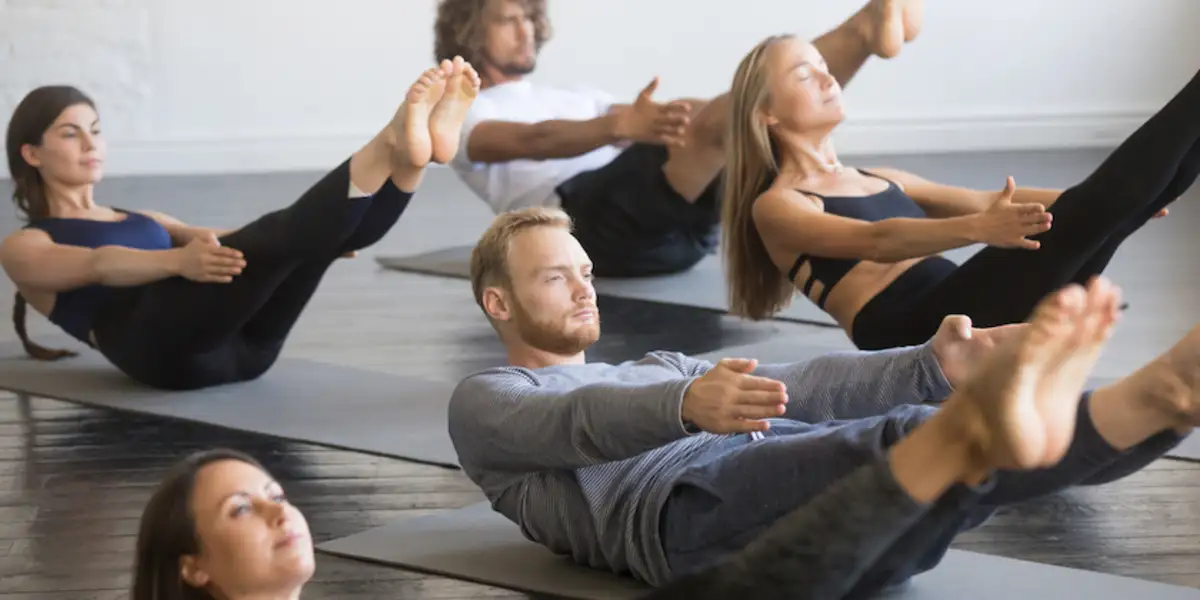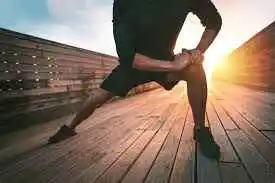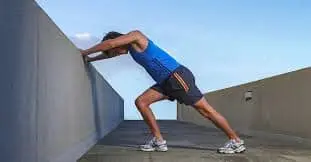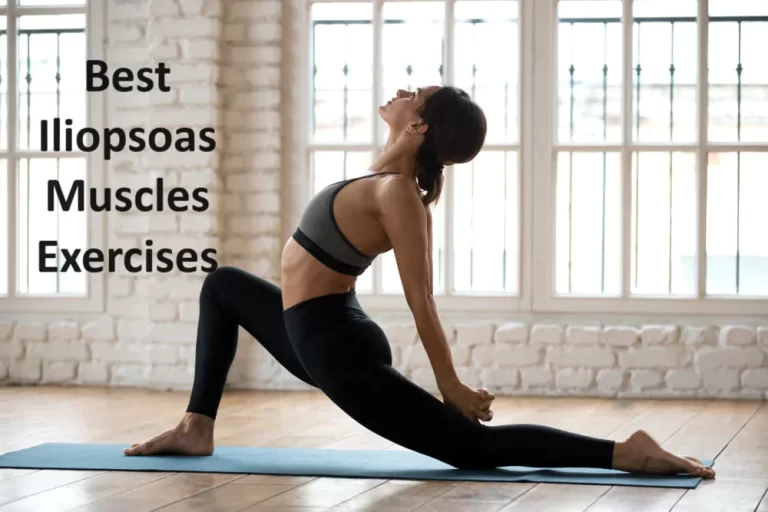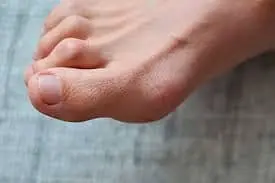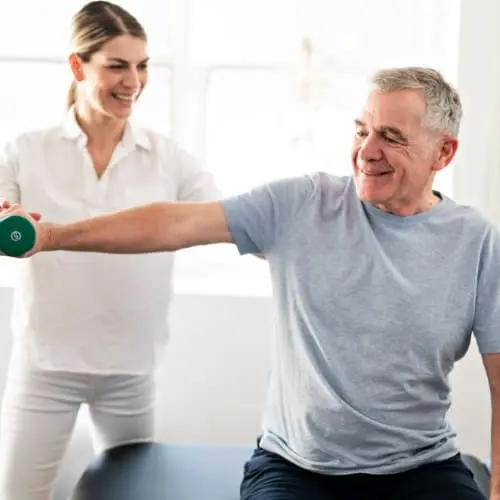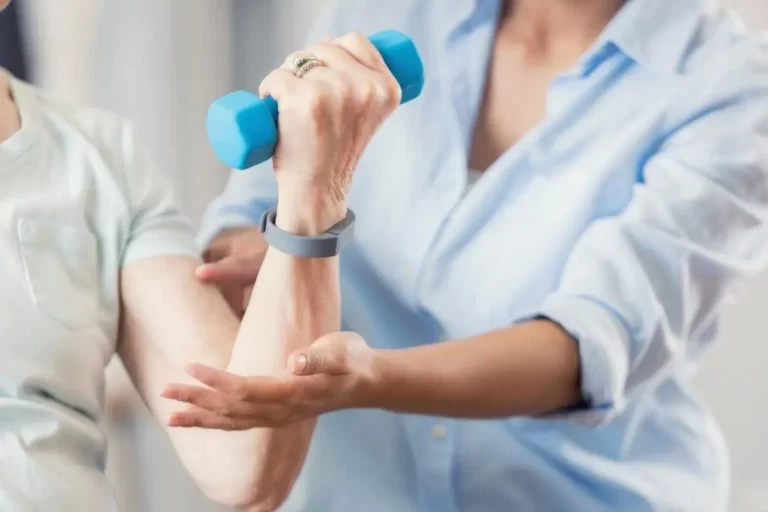Pilates
What is Pilates?
Pilates is a workout regimen designed to enhance the body’s potential by repairing muscle imbalances, determining appropriate alignment, and developing adequate movement patterns. Mixing Pilates movements with breathing exercises works your entire body’s muscles.
Joseph Pilates invented this exercise in the early 1900s when it was referred to as “Contrology.”
It is widely recognized for focusing on the core’s smaller and deeper stabilizing muscles. Pilates improves your body’s system by balancing strength, suppleness, and flexibility; each workout engages your core. It can influence mat work, low-impact bodyweight activities, and technical equipment.
Pilates has several advantages. Maintaining a strong core with Pilates can help minimize low back discomfort, improve balance, and lower the chance of falling. This will benefit your quality of life by reducing depression and anxiety.
There are several fantastic core exercises available, and strength training in general, particularly when challenging yourself with heavy weights and deliberately using your core during the motions, works those muscles. Pilates exercises, on the other hand, emphasize the core, which makes them perfect for targeted core treatment.
This is a type of exercise where you do a series of well-planned exercises that build upon each other. Pilates is officially considered a total-body activity, regardless of which muscles it targets.
Pilates utilizes all of the muscles in your body, but it particularly targets the following core muscles:
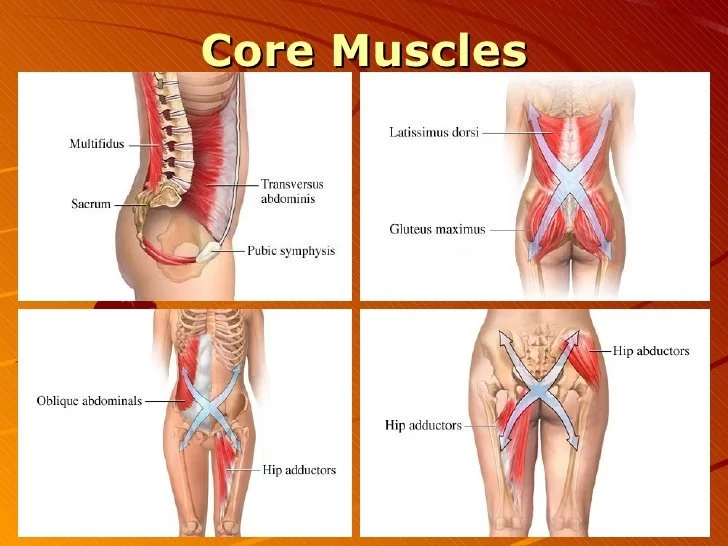
- Abdominal muscles
- Hip muscles
- Gluteal muscles
- Lower and upper back muscles
- Inner thigh muscles
Retaining total control over your body while moving is the aim. This must begin with your center core muscles and utilize the stability they give to effortlessly manage your arms, legs, and other extremities.
What is the powerhouse?
It’s common knowledge that your core, sometimes known as your powerhouse, is made up of muscles other than your abdominals.
It takes up the middle part of your body, running from your lower back to the bottom of your rib cage. It includes the pelvic floor, glutes (also known as buttock muscles), inner thighs, and lower back muscles.
Consider it your body’s corset but without the constraining qualities. This site helps your organs stay in their normal place and improves their performance.
The powerhouse works in tandem with your breath to maximize efficiency. To acquire flexibility, instead of continually grasping or bracing, strive to strike a balance between activation and relaxation.
What are the benefits of Pilates exercises?
Pilates is really handy for everyone. Pilates mat exercises don’t require any equipment, however, there are regular exercises you may perform on the Pilates reformer.
Fitting in Pilates at home is also appropriate and beneficial. Strength, flexibility, balance, coordination, and breath awareness may all be enhanced with Pilates. Additionally, being a scalable training modality, Pilates offers a variety of beginner-friendly exercises and advancements and interpretations for more seasoned professionals.
Some advantages include:
- Enhances flexibility
- Improves core strength.
- A challenging low-impact mode of exercise
- Can improve posture and stability.
- This may be done without any tools.
- Increases flexibility and range of movement.
- Improves muscular endurance and strengthens muscle tissue.
- might be carried out as a part of physical rehabilitation therapy or after an injury.
Pilates principles
Pilates has six fundamental concepts that are vital for maximizing each session.
- Centering: It’s all about learning to recognize the base of your body, which is situated between your pubic bone and lower ribs.
- Concentration: To get the most out of each workout, give it your entire attention.
- Control: The goal is to achieve complete muscle control while moving gently and steadily.
- Precision: Concentrate on proper alignment and core engagement while aiming for super exceptional form.
- Breath: Coordinate your Pilates exercises with your breathing, one movement on the inhale and one movement on the exhale.
- Flow: Try to move as fluidly as you can throughout each Pilates practice, following your breath.
What kind of training is Pilates?
Pilates places a strong emphasis on muscular balance, core strength, and appropriate posture. It is excellent for correcting muscle imbalances, rehabilitating injuries, and preventing future injuries.
There are various types of Pilates:
- Classic Pilates: The traditional Pilates method calls for performing the movements in a set order.
- Mat Pilates: mat-based workouts.
- Contemporary Pilates: A mix of classic and innovative Pilates movements performed in varied sequences utilizing a variety of tiny objects.
- Reformer Pilates: A strenuous version of Pilates that uses a ‘Reformer’ to enhance resistance and challenge strength.
- Clinical Pilates: Physiotherapists prescribe injury and rehabilitation-specific movements.
Does Pilates count as training?
Although Pilates is the purest type of exercise, its execution is difficult. It is considered a muscle-strengthening activity. You can work out your entire body with Pilates.
Is Pilates safe during pregnancy?
If you’re expecting, Pilates might be one of the most beneficial methods to move your growing body. Not only is it safe, but it is something I firmly feel all pregnant women should include in their exercise routine.
Here are some of the benefits for mothers-to-be.
- It helps the muscles most affected by pregnancy (such as the abs, glutes, and pelvic floor).
- This is a low-impact activity.
- It can alleviate back discomfort.
- It helps to keep you mobile.
- It improves equilibrium.
Many women may experience the “burn” of pregnancy using this safe and advantageous method, knowing that it won’t have an impact on their health or that of their unborn child.
It’s never too late to begin Pilates if you haven’t done so before becoming pregnant.
How to get started:
- Speak to your doctor. It is usually a good idea to consult a doctor before starting a new fitness plan. Pilates is an excellent choice for those with a variety of chronic medical issues, but depending on your circumstances, you may need to modify your routine significantly. It is especially crucial to consult a doctor if you are injured or recuperating from surgery. Although Pilates can be beneficial, beginning too soon might exacerbate the situation.
- Make sure you have a qualified instructor. Even if you do mat exercises at home, you still want a qualified Pilates teacher. If you practice these workouts for specific health reasons, you will require a skilled trainer. Patience is one of the characteristics of a good educator. When practicing Pilates in a group or one-on-one setting, Pilates recommends that the routines begin easy and progressively rise in complexity. You can’t just jump right in; your teacher needs to know.
- Begin slowly: Even if you’re a fitness aficionado, you should start your Pilates practice cautiously and gradually before progressing to more challenging levels. Because you are training your body with new movement patterns, you can expect some stiffness.
- Remember that it is never “easier” to use a reformer than a mat. Pilates has both advantages and disadvantages, and it is not an easy exercise. Both strategies are often employed in-studio classes. Using a mat forces your body to defy gravity. Freeform Pilates might be more taxing on the back than reformer exercises. Although reformers may be purchased for home use, Bar recommends working with an instructor to learn proper alignment. They will monitor you as you work to ensure that each activity is performed safely and properly.
- Do what’s right for you. There is a widespread misconception that Pilates is only for wealthy and physically fit people. The price might be high, but if you look about, you can usually find fantastic offers. For example, purchasing sessions or class bundles typically lowers the cost of classes. When deciding on an activity for your Pilates practice, consider your level of fitness and comfort, such as studio vs. home, solo vs. group, mat vs. reformer, and so on.
Pilates vs. yoga
Although all exercises are mostly done on a yoga mat, there are some notable differences in the programs.
Pilates focuses on strengthening and relaxing certain muscles, which sets it apart from yoga. Yoga is practiced to improve the body’s flexibility.
Both disciplines provide significant benefits. Depends on your plans. It improves deep core strength, muscle control, stability, posture, and coordination while increasing muscular endurance.
However, if you want to increase your flexibility and incorporate a spiritual element into your training, yoga may be a better fit for you.
Which are great Pilates core exercises?
Exercises that are excellent for building core strength include Pilates One Hundred, the roll-up, and the single-leg stretch. There are also many that, even though you might not know them by name, you might remember them once you see them.
To focus and engage your core, you may choose a couple of these Pilates core exercises to perform as a warm-up before training or add some of them into your next workout. Additionally, you may select a few of your favorite movements and do them for a few minutes at a time to establish a stand-alone practice if you’re just looking for a quick movement session. Try performing a move for thirty seconds at first if you’re new to these exercises, then work your way up to a minute.
We’ll talk about core muscle-strengthening exercises here.
Leg Circle
- You must lie on your back to begin this exercise with your palms facing downward.
- Your left knee should be bent, and your foot should be flat on the ground.
- Make the circle as big as you can while maintaining your lower back on the floor.
- the reverse of the circle.
- One leg at a time, do all reps and then switch to the other leg.

Pilates One Hundred
- Lift both legs toward the sky while bending at the knees.
- Stretch your long arms parallel to your body, palms down, while maintaining a high head.
- Firmly raise and drop your arms while inhaling and exhaling five deep breaths.

Single-Leg Stretch
- Lie down in a supine position.
- Place your hands on your shins, raise your head off the floor, and bend both knees towards your chest.
- Stretch each leg separately, switching sides as you go.
- Keep your core strong and your lower back flat throughout.
Criss-Cross
- Keep your elbows wide and place your hands on the back of your head.
- Stretch your left leg and bring your left shoulder to your right knee. Next, extend your right leg and sag your right shoulder toward your left knee.
- Repeat on the other side.
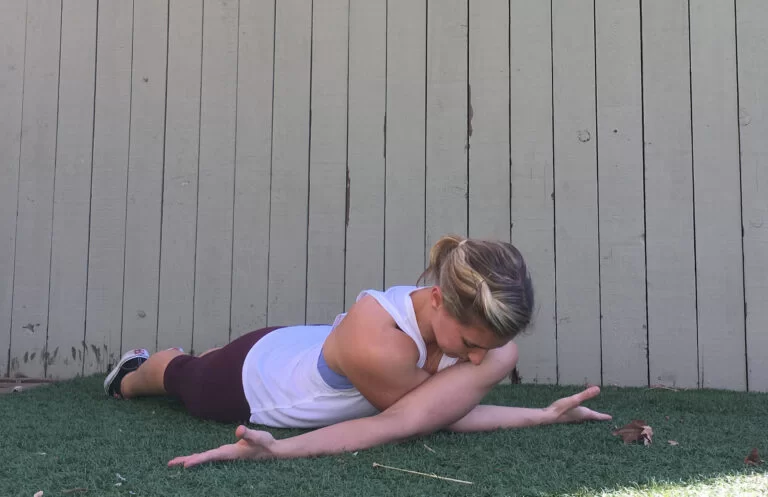
Double Leg Stretch
- Tuck both knees in close to your chest while lying face up.
- Stretch your legs out in front of you and raise your arms to the sky. Strive to stand with your legs as straight as you can, keeping your lower back on the ground. Bring your knees back to your chest as you stretch your arms and wrap them around your knees.
Pendulum
- You must lie down on your back with your arms by your sides to begin a pendulum workout.
- Legs should be raised off the mat, knees should be bent over hips, and the position should be released.
- Maintaining your lower back on the ground, flex both knees to the right.
- Return to your starting location after doing the same on the other side.
Scissor Kick
- Assume a face-up position.
- Lift and place your right leg squarely on the ground. Raise your head and place your hands behind your right leg as it comes closer to your face. Elevate your left leg a few inches above the floor.
- It would help if you switched legs so your right leg is dangling freely over the floor and your left leg is coming closer to you.
- Continue switching up your legs.
Teaser
- Assume a face-up position. Curl your knees over your hips and raise your feet off the mat.
- Stretch your legs, lift your head and shoulders off the ground, and bend your arms toward your feet.
- After five breaths, turn onto your back and bend your knees once again.
Roll Up
- With your arms raised over your head and your feet flat on the ground, lie on your back.
- Float your arms up until your wrists are directly over your shoulders as you gradually elevate your spine off the floor, moving from your shoulders down to your lower back.
- Maintain a solid core by sitting up straight and folding your torso over your legs. To undo the motion and return to the ground, roll from your lower back to your shoulders.
Plank Leg Lift
- As an alternative, try lifting one leg off the ground as high as you can without going beyond shoulder level.
- Maintain an engaged core, butt, and quadriceps to avoid swinging your hips.
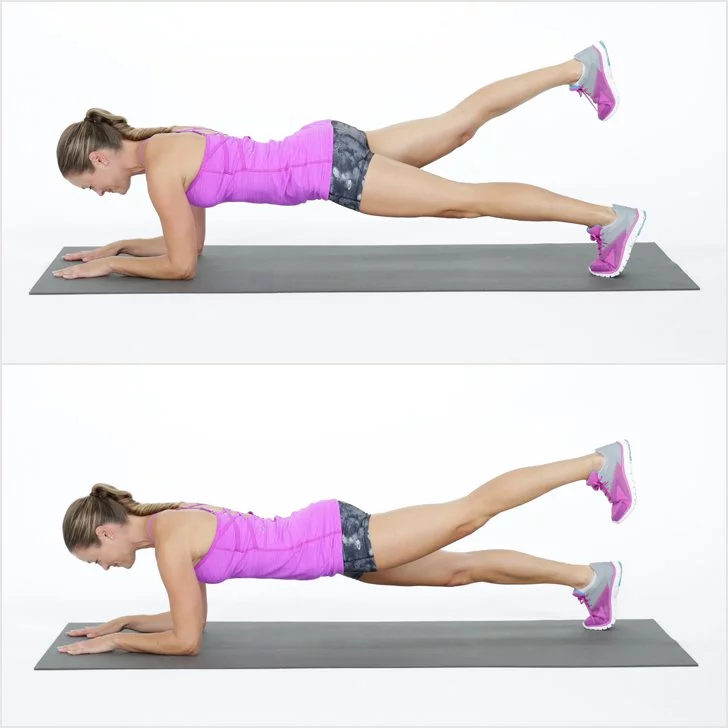
Plank Rock
- Take a stride backward toward your heels after propelling your entire body forward toward your hands.
- Maintain constant activation of your quadriceps, butt, and core.
Slow Motion Mountain Climber
- One by one, bring each knee in closer to your chest.
- Maintain an engaged core, butt, and quadriceps to avoid swinging your hips.
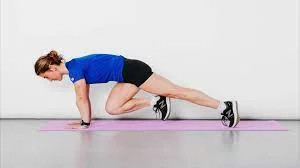
High Plank to Pike
- Assume a high plank position, with your legs stretched, abs tight, shoulders stacked over your wrists, and hands shoulder-width apart (or wider if you regularly perform push-ups).
- Exhale to raise your tailbone toward the sky and extend your legs as far as you can. You can lower your heels to the ground by bending your knees if necessary. One rep is equivalent to this.

Hip Dip
- Put your left foot over your right and your right hand exactly under your right shoulder to form a side plank stance.
- Your hips should first descend to the floor before rising back up. Repeat ten times before turning left.
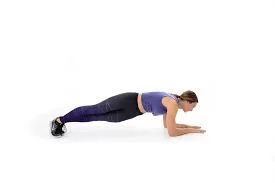
Bird-Dog Crunch
- Assume a tabletop posture on your hands and knees with your knees behind your hips and your wrists behind your shoulders.
- Now, slap your foot against the wall behind you.
- Squeeze your abs and bring your left knee and right elbow together in the center of your body.
- Next, take the opposite action and extend your leg and arm once again.
- One is a representative. Once a set number of reps are completed, repeat with the second arm and leg.
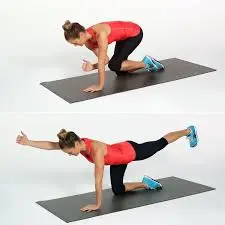
Toe Tap
- Lay on your back with your feet flat on the ground and your arms at your sides.
- Your knees should be in a 90-degree angle. Everything starts at this point.
- Your feet should eventually come into touch with the floor.
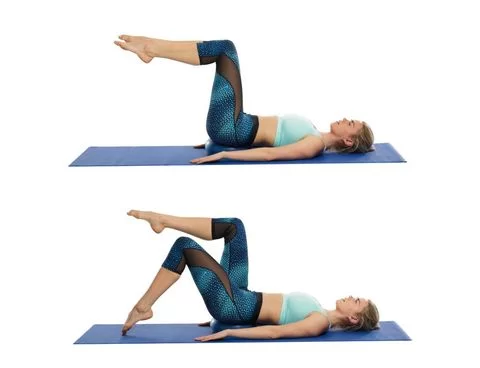
Push-up
- You will place your hands somewhat wider than your shoulders while on all four limbs as you prepare to complete a push-up. Rather than locking the elbows out, keep them slightly flexed. When your feet are hip-width apart and you are standing on your hands and toes, pull your legs back.
- Pull your belly button toward your spine to tighten and strengthen your core.
- Inhale as you gradually bend your elbows and descend to the floor, bringing your elbows up to a 90-degree angle.
- exhale, tightening your chest muscles and raising yourself back up using your hands to take the original position.
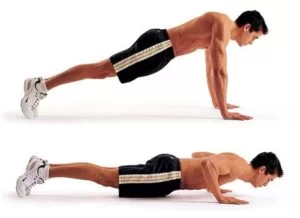
Bridge
- With your knees bent and your heels parallel to your lower torso, lie flat on your back with your arms at your sides in a comfortable position. Take a big breath in, and as you exhale, flatten your lower back to the ground as if elevating your tailbone to the roof.
- Your head should feel comfortable, so don’t press it down to the bottom. You should be conscious of your buttock muscles contracting to maintain the rise.
- When ready to breathe in, return to the mat one vertebrae at a time, beginning with the upper back, moving down to the mid back, and lastly to the lower back. If you feel a twinge in your hamstrings when exercising, move your feet closer to your hips.

Kneeling sidekick
- Lie on your chest on a mat, palms close together, in a push-up posture.
- Place your elbows beneath your shoulders and make first contact with them. That provides a proper stretch for your forearms.
- With your knees together and your pubic bone pressed against the mat, raise your abdominal muscles just a little bit.
- Extend your right leg from the knees such that your heels are attempting to touch your buttocks. However, it will be a single fast action. Pulse twice at the height of the movement before returning to neutral.
- Perform it alternately on each leg for at least 10 to twenty repetitions.
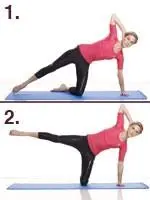
Double-leg kick
- Lying on your tummy, stretch and compress your legs together. With your face resting on one cheek, your arms should be relaxed and your fingers locked behind your back.
- Exhale, bend both legs, and pulse your feet in the direction of your buttocks.
- Inhale, arch your back, place your head in the middle, and extend your legs and arms behind you. Reduce your body height, then lay your face on the opposite cheek, and repeat.
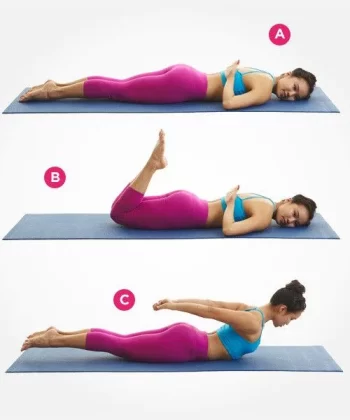
Control Balance
- To begin this exercise, lie on your back with your legs flexed and pointing towards the roof. Arm stretched above your head.
- Carry both legs up to a 90-degree angle before extending them straight out at an angle.
- Once your legs are parallel to the floor and back to your chest, hold that posture for five seconds.
- Point straight up with your legs while maintaining a straight posture.
- Maintain this stance and gently lower your right leg to your hands before slowly raising it again.
- Then swap, gently lowering and raising your left leg. Perform 10-15 repetitions of back-and-forth alternating.
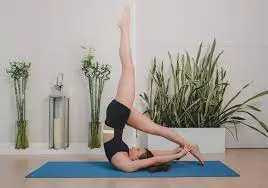
The saw
- Legs apart and feet flexed while sitting tall. Extend your arms horizontally and vertically.
- Breathe out, pivot to the right, and lunge forward, attempting to make contact with your right foot with your left arm. Make a left turn, then come back to the middle and do it again. On each side, repeat this thirty times.
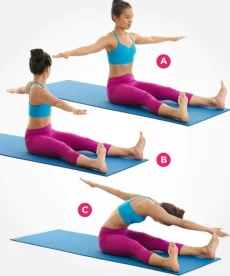
The swan dive
- Place your hands on the mat between your shoulders and head while resting on your stomach with your legs connected.
- By extending your arms straight in front of you, you may raise your upper body off the floor. Your torso should have an arc in it.
- As your body swings forward while maintaining its arc shape, extend your arms straight out. As a result, you will need to raise your legs off the pad behind you.
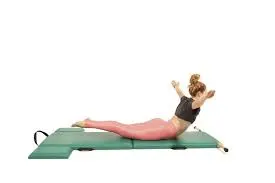
The scissors
- To begin this exercise, lie supine on the mat, head and shoulders lifted.
- Both legs must be elevated to the ceiling, with your feet plantarflexed.
- The right leg was extended in the air toward the body.
- While doing so, maintain a gentle grip on the leg and keep your abdominals engaged.
- Breathe in and then swap legs.
- Breathe out.
The bicycle
- Place your knees up to your chest while lying on the mat. Your arms should be alongside you as you extend your legs toward the ceiling.
- Next, lift your legs and adopt a neutral posture with your hips squared and your shoulders back. Verify that your neck isn’t being strained in any way.
- To help you balance, place your hands behind your hips. Then, push your pelvis forward to exert pressure on your hands.
- Your legs will come rearward but retain a 45-degree angle.
- The objective now is to cycle in reverse. It would help if you paddled with your right leg toward the mat and yourself. Your right leg rises back up, and your left leg smoothly approaches the mat.
- Repeat each leg at least ten times, switching legs every few reps.
- When you’re finished, carefully bring your legs to the mat while keeping your hip stance to avoid collisions.
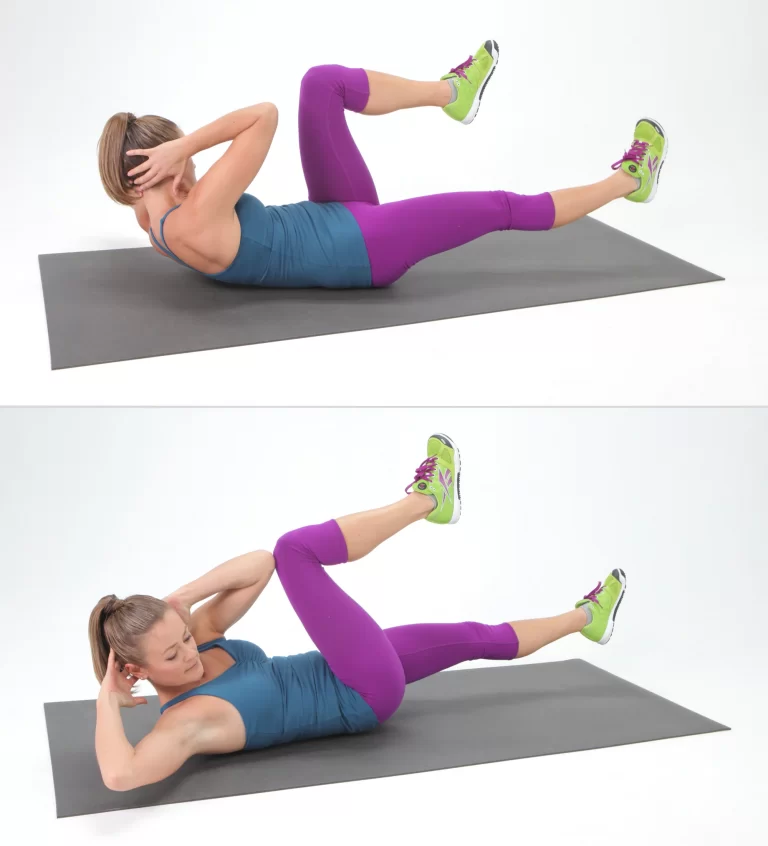
The spine twist
- Sit on the ground with a straight spine. Verify that your shoulders are not hunching over and that your core muscles are tight. Your upper body will have enough support from this.
- Stretch your arms to the sides and extend your legs forward until your fingers are parallel to your shoulders.
- At this moment, you are ready to start training.
- Turn your upper limb to one side, making your spine higher as you twist.
The Boomerang
- Begin by sitting up straight and extending your legs in front of you, with your heels twisted.
- Cross your left ankle over the right. Pull your abdominal muscles in while you sit up straight and take a deep breath.
- Roll your body back one vertebra at a time while inhaling, keeping your legs extended, until your hips and shoulders are levels. Lay your arms out flat on the mat with your palms facing down.
- Legs should now be alternated such that the left ankle now rests on the right. To do this, you swiftly breathe while opening and closing your legs simultaneously.
- At the point where your legs are 45 degrees from the floor, release the air and roll your body back up. Put your ankles back together in the crossing position and clasp your hands behind your back.
- On an exhale, return your knees to the floor and tilt your body forward until your head hits your chin. Place your arms behind your back and straighten them.
- Release your grasp, circle your arms forward, and relax into the stretch.
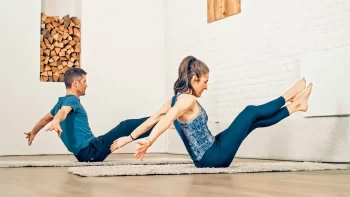
The seal
- Get down on the ground, knees slightly bent. With your hands outside of your ankles, bring them in toward your center.
- Arms raised overhead, knees pushed through to maintain balance on hands and feet.
- Bring your stomach in firmly and stretch your lower back until you feel solid before rolling up onto your toes.
- Scoop your abs up, creating a C-curve with your torso.
- To start, give three firm foot claps.
- Inhale and roll back onto your shoulders, starting with your lower belly (not your neck). Clap your legs three more times when you reach the top.
- Breathe in to assist you roll back up, exhale, and engage your deep abdominal muscles.
- Roll forward to assume your starting position, pointing your feet toward the mat in front of you. To achieve balance, hold for a second.
- Repeat 4-6 times. Clap with your feet together to keep the movement’s rhythm intact.
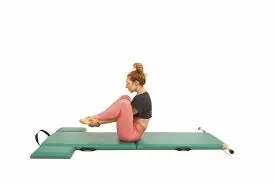
The rocking
- Lie on your stomach. Inhale, bend your knees, and extend your arms back to grasp your ankles as you raise your torso and legs into an arch.
- Breathe out and rock forward.
- Breathe in, raise your chest, and push off your ankles as you land backward. Keep your belly pressed up against your back.
- Rock back and forth five times. To finish the posture, release your ankles, sit back on your heels, and extend your arms in front of you.
- Place your forehead on the carpet. This is similar to a child’s pose.
During the workout, precautions are taken:
People have reported feeling dizzy when working exercise, particularly during weather shifts. In such circumstances, you must notify your teacher to change your form. If you’re practicing by yourself, observe these guidelines:
- Point your feet toward the mat in front of you as you roll forward to take up your starting position. You may also use a pilates block to support your neck.
- If your back hurts, place pillows under it.
- If you are experiencing knee pain, apply an elastic band.
These gadgets are widely accessible and incredibly beneficial, particularly for Pilates beginners and those suffering from back, neck, knee, or joint problems. It is important to use caution so as not to damage oneself. You’ve worked so hard for your physique, so don’t jeopardize it.
When you should not perform this Pilates exercise?
Chronic Medical disease:
- Certain chronic medical conditions
- Such as heart disease
- High blood pressure
- Diabetes
This person may require modifications to specific Pilates exercises or perhaps the entire avoidance of certain activities.
FAQs
For what Pilates is most effective?
increased flexibility, tone, and strength of your muscles—particularly those of your lower back, hips, buttocks, and abdomen—as well as balanced strength on both sides. Gain more control of your back and leg muscles.
Is Pilates a good way to reduce Weight?
Unlike many high-intensity exercises, Pilates does not burn a lot of calories, but studies have shown that it can help you lose weight. A 2021 study discovered that Pilates can significantly reduce body weight and body fat percentage in overweight or obese persons.
Does Pilates assist in reducing belly fat?
While Pilates will burn calories, it is a fallacy that it will help you lose belly fat. Regardless matter how much you exercise, you will not notice a drop in fat anyplace on your body.
Can Pilates decrease thigh fat?
You may use a variety of pilates routines to target your thigh fat. Pilates side leg sequence consists of 5-10 movements performed while laying on the side of the body. They target and tone all of the muscles in the lower limb.
Can we try Pilates during periods?
You may work out with Pilates on the first or end day of your menstrual cycle.
References:
- Tirgar, P. (2023b, December 13). Pilates – Strengthen Your Core and Improve Your Flexibility. Mobile Physiotherapy Clinic. https://mobilephysiotherapyclinic.in/pilates/
- Menzies, R. (2021, April 26). Core Galore: 15 Pilates Exercises to Develop Your Powerhouse. Healthline. https://www.healthline.com/health/fitness/pilates-exercises#exercises
- Robinson, K. M. (2024, May 2). Pilates. WebMD. https://www.webmd.com/fitness-exercise/a-z/what-is-pilates
- CPT, A. M. W., & CPT, C. S. (2022, March 3). 17 Amazing Pilates Exercises That Work Your Core—And You Can Do Right at Home. SELF. https://www.self.com/gallery/pilates-exercises-that-work-your-core

